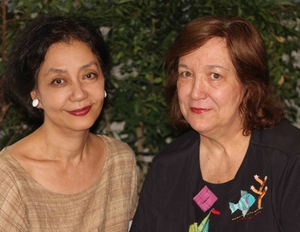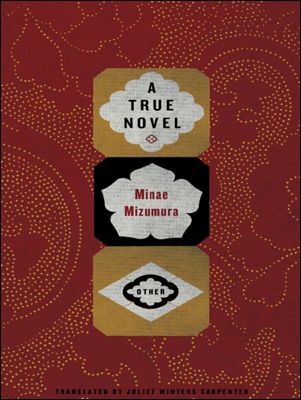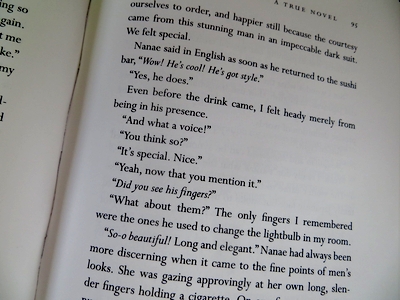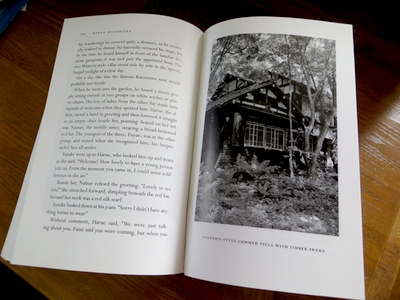September 23, 2014
True Collaboration on A True Novel
Interview by Anna Zielinska-Elliott and Lynne E. Riggs
 Juliet Winters Carpenter is a well-known translator of Japanese literature and research professor at Doshisha Women’s College of Liberal Arts in Kyoto. Her list of translations is very long and includes works by Abe Kōbō, Tawara Machi, Enchi Fumiko, Shiba Ryōtarō, and many other writers. Her recent translation of Minae Mizumura’s* A True Novel, published in 2013 as part of the Japanese Literature Publishing Project, has won the 2014 Next Generation Indie Book Award’s Grand Prize in Fiction. It was also a runner-up for the 2014 Best Translated Book Award. A True Novel is a story within a story. The “outside” story is narrated by a Japanese writer, named Minae Mizumura (like the author). The narrator claims that what she writes is based on real events. The protagonist of the “inside” story told within the novel is Taro Azuma, a Japanese man whom the narrator used to know as a girl growing up in the United States. Taro comes from a very modest background but gains wealth and success in America; yet all the while he remains devoted to his first love, Yoko.
Juliet Winters Carpenter is a well-known translator of Japanese literature and research professor at Doshisha Women’s College of Liberal Arts in Kyoto. Her list of translations is very long and includes works by Abe Kōbō, Tawara Machi, Enchi Fumiko, Shiba Ryōtarō, and many other writers. Her recent translation of Minae Mizumura’s* A True Novel, published in 2013 as part of the Japanese Literature Publishing Project, has won the 2014 Next Generation Indie Book Award’s Grand Prize in Fiction. It was also a runner-up for the 2014 Best Translated Book Award. A True Novel is a story within a story. The “outside” story is narrated by a Japanese writer, named Minae Mizumura (like the author). The narrator claims that what she writes is based on real events. The protagonist of the “inside” story told within the novel is Taro Azuma, a Japanese man whom the narrator used to know as a girl growing up in the United States. Taro comes from a very modest background but gains wealth and success in America; yet all the while he remains devoted to his first love, Yoko.
The story begins in 1950s postwar Japan and ends over 40 years later. Set in Tokyo and Karuizawa, it tells the tale of several families against the background of a rapidly changing Japanese society. Parts of the book are set in the United States, beginning in the 1960s, where the country is seen through the eyes of Japanese expatriates. The plot and characters are loosely based on Emily Brontë’s Wuthering Heights: Taro is reminiscent of Heathcliff; his love interest, Yoko, has some similarity to Catherine; and the unreliable narrator, Fumiko, is a former maid, as was Ellen Dean in Brontë’s novel. A True Novel consists of two volumes that total over 850 pages in English.
A True Novel is a fascinating read, a great story with a rich and multilayered background. The English translation is excellent and does full justice to the original work, maintaining the same level of complexity and depth. Since Mizumura grew up in the United States and knows English well, she was able to collaborate with Carpenter during the translation. Carpenter agreed to answer a few questions about this process for SWET.
Anna Zielinska-Elliott: I have truly enjoyed reading A True Novel in English. I got caught up in the plot and couldn’t put it down! I was very impressed by the translation.
Juliet Winters Carpenter: Thank you!
AZE: Did you want to translate the book and suggest it to the publisher, or did the publisher approach you?
JWC: I was invited by a representative of the Japanese Literature Publishing Project to jump aboard. I was in the middle of two other mammoth projects—a translation of a
commentary on the Tannishō, a classic of True Pure Land Buddhism, and the multivolume Clouds above the Hill by Shiba Ryōtarō—so I wouldn’t have signed up for it on my own. When the invitation came, though, I realized it was too precious a chance to let slip. One of the smartest things I have ever done!
 AZE: I would like to ask about possible and obvious influences. First, we know that the plot is loosely based on Wuthering Heights. Were there any other novels that came to mind when you were translating the book? Did you refer to Wuthering Heights?
AZE: I would like to ask about possible and obvious influences. First, we know that the plot is loosely based on Wuthering Heights. Were there any other novels that came to mind when you were translating the book? Did you refer to Wuthering Heights?
JWC: I looked at Wuthering Heights after doing the translation—I had read it before, and didn’t see any real reason to read it again while translating the book. Echoes of Wuthering Heights come up constantly, of course. Other stylistic influences are from Sōseki and The Tale of Genji. Mizumura told me that she patterned Fumiko’s voice after the ladies-in-waiting in Genji. You could also substitute Gatsby for Taro.
AZE: I read Susan Chira’s review of A True Novel in the New York Times and am very curious how you feel about this statement from the review: “Yet Mizumura has triumphed in taking a quintessential Western Gothic and making it wholly Japanese. . . . At least between its pages, Western tradition does not eradicate Japanese literary sensibility. She has drawn on the West for inspiration but created something indelibly, irresistibly, Japan’s own.” What do you think about the urge some critics seem to feel to create such dichotomies between “Japan” and “the West”? Are these categories still valid, in your opinion, especially in the case of a writer who tries to straddle both cultures?
JWC: This is an interesting question. I was actually pleased by Chira’s statement, since the novel is admittedly based on a Western classic and yet draws from Japanese history
and literary traditions as well. Certainly the human experience is largely universal—which is why translation is possible in the first place, and why Mizumura can be inspired by different literary traditions simultaneously—but the particulars of that experience vary among cultures, and a clumsy imitation could end up sounding a bit ridiculous. I think of TV dramas made in Japan where Japanese characters go on having conversations that grate on the ear, grown siblings saying things like “Do you think Father still loves Mother?” Japanese people just don’t talk that way, even if some Westerners do. I think the novel is a successful transposition of a Western framework into Japanese, and more, and if that comes across in the translation, then great.
AZE: I think the title, A True Novel, is very clever because it can be taken as meaning that it is a true story, based on real events, while it also works as a translation of the phrase honkaku shosetsu (本格小説). Did you consider other titles before you came up with it?
JWC: The French title is Taro, un vrai roman, so we did consider doing something similar in English. Encyclopedia Britannica still gives the title as “Genuine Novel.”
AZE: I was very impressed by how you seamlessly wove into the text little explanations about Japanese things and places. I also noticed a longish fragment explaining the history of Karuizawa. Did Mizumura write it especially for the American edition? Or did you come up with it?
JWC: A lot of rewriting went into the final version. I don’t know how carefully you compared the translation and the original, but the description of Karuizawa is a good example of something inserted into the text for the benefit of Western readers. I would certainly hesitate to write anything that extensive all by myself. When a longer passage such as that needs to be inserted, Mizumura writes it herself in either English or Japanese, I translate/rewrite it, and then we go over it together—usually quite a few times before it’s finalized. This was the same procedure we followed for the book The Fall of Language in the Age of English [Also available on Amazon Japan - Ed.], which is forthcoming from Columbia University Press in January 2015. Shorter things I may do myself, or she may ask me to come up with something.
Lynne E. Riggs: You have mentioned that you and Mizumura worked together closely on the translation. Could you tell us more about the process?
JWC: I would have to say the entire translation was a collaboration. (In fact, the paperback edition will say just that—translated by yours truly “in collaboration with the author.”) Before I became involved, another translator worked on the first half, but she ended up having to withdraw for various reasons. I therefore originally signed on to do only the second half: volume 2 in the Japanese edition, starting with “Lightbulbs.” (The idea that I would have to do “only” half the book, while clearly a pipedream, was another factor that helped me commit to the translation.) While I was working on my half, Mizumura herself went over the first half, putting unimaginable effort into trying to redo the still-rough translation to her satisfaction. She probably shortened her life in the process. I understand that her longtime American friend, a novelist named Anna Shapiro, gave her considerable help along the way, but the whole thing was apparently too much for Mizumura and took a great physical and mental toll. Eventually I realized what she was doing and felt terrible. In the end I worked equally hard or harder on the first half, which four people before me had had a hand in: the original translator, Mizumura, Shapiro, and editor Stephen Shaw. I can truthfully say that Mizumura and I went over every word of the entire novel together, more than once. We also continued to work with the great Stephen Shaw and benefited enormously from his insights and down-to-earth comments—while not necessarily accepting everything he said, either. All of that had to be worked through, line by line. It may sound grueling, and I guess it was, but Mizumura and I were on the same wavelength and it was fun, too. I should also mention the many contributions of her friend Toyota Horiguchi, who designs her books, takes the photographs in them, and offers every other conceivable kind of technical and moral support. I also benefited greatly from his help. I particularly remember the night before we had to turn in the final translation to Other Press—we stayed up working till 5 a.m.—I just had time to go home and shower and sleep for maybe an hour before going to campus to teach three classes. I guess my adrenaline was pretty high.
 LER: Could you share some examples of the kinds of places in the book that were the focus of your particular collaboration?
LER: Could you share some examples of the kinds of places in the book that were the focus of your particular collaboration?
JWC: Here is a passage from the second half—Fumiko commenting about Masayuki and Taro visiting Yoko in the hospital (p. 841). First is the Japanese, followed by my
rendering (JWC), then Stephen Shaw’s edited version (SS), then the collaborative wording (JWC&MM). I think you can see how it comes into sharper focus.
看護婦さんたちの中には見るからに立派な二人がとっかえひっかえ出入りするのをぼうっと上気してみている人もいますが、働き盛り分別盛りにある男の人たちがこうして交代交代で見舞いに来るだけの日を送っているのは、いくら正月休みとはいえ、何か世の中に対して申し開きができないような気がわたしはしました。これが最後になるとは思ってもいなかったからです。(p. 438)
Sentence 1 of the English translation rough draft: Some nurses looked on with wonderment at the constant comings and goings of these two stunning gentlemen. →
SS: Some of the nurses seemed curious about the constant coming and going of these two good-looking men. →
JWC & MM: Some of the nurses seemed star-struck at the alternating appearances of these two dashing men.
Sentence 2 rough draft: I myself thought the situation rather ludicrous. I never thought that this would be the end. →
SS: I myself found it a bit ludicrous. I never imagined that this would be the end. →
JWC & MM: I myself found it a bit ludicrous that two men in the prime of life should spend all their time taking turns coming to see her in the hospital, getting nothing else
done—even granting it was New Year’s vacation. I never imagined that this would be the end.→
JWC & MM: I personally found it a bit ludicrous that two busy grown-ups should spend all their time taking turns coming to see her in the hospital, getting nothing else done—even granting it was New Year’s vacation. I never thought that this would be the end.
Mizumura often wanted the sharpness of Fumiko’s disapproval to come through more clearly, as it ends up doing here. This was a recurring pattern: Stephen would pare and simplify, and this would serve to highlight what wasn’t coming through in the text, so that we would return to it and rethink the premise of the passage to bring out its underlying meaning more clearly.
Since the part omitted from the first two versions of the second example above is present in the original, clearly for some reason it was cut and then reinstated. Just how it all happened is a bit fuzzy in my mind now. . . and I suppose if I did it now, it would all end up differently! Finally, here is how I changed something in response to a request from Mizumura. This is Fumiko recalling the moments just after Yoko’s death (p.852 in A True Novel).
ところが非常口を出て冬の夜空の降るような星のあいまから細い月が清さやかにアスファルトの駐車場を照らしているのを見たときです。よう子ちゃんが死んでしまった。(p. 456)
Rough draft: I went out the emergency exit. I saw the wintry sky filled with countless stars. Then I saw how, through those countless stars, clear light from the sliver of moon shone on the asphalt parking lot. That’s when it hit me. Yoko was dead.
SS: I went out by the emergency exit. I saw the wintry sky filled with stars. Then I noticed, in addition to those stars, the light of the moon on the asphalt parking lot. That's when it sank in. Yoko was dead.
(Mizumura request: Could we do something more with the description of the moonlight?)
JWC: I went out by the emergency exit. I saw the wintry sky filled with stars, and from among them fell shards of moonlight, glittering on the asphalt parking lot. That’s when it sank in. Yoko was dead.
So yes, it was a mutually creative process.
AZE: These examples are fascinating! I would like to know more about the logistical side of the collaboration. You live in Kyoto and Mizumura lives in Tokyo, right?
JWC: We would work separately and communicate by email, but then always meet in person to go over things together. The process was often exhausting, but at the same time exhilarating. At one point I stayed with her in Karuizawa (Oiwake) for an entire week. Other times she would come down to Kyoto for an extended stay, and we would work in a friend’s apartment, often putting in eight-hour days over a period of a week or two. Eventually we developed a rhythm—a day apart, a day together, and so on. Rinse and repeat, rinse and repeat. I would have to say there are few people in the world I feel so close to as her. At the same time, I can only thank the translation gods for letting me have this rare experience with a writer so gifted and so passionate about what she does.
LER: Mizumura’s abilities in English are of course unusual, and I wonder if she ever attempted to write in English from the outset.
JWC: Mizumura is definitely a Japanese writer, although her first published work was in English—a widely praised scholarly essay on the literary criticism of Paul de Man. But fiction is a different matter, and when she decided to become a full-time writer she made the deliberate choice to write in Japanese, the language closest to her heart. Anyone wanting to know more about what it means to her to write in Japanese instead of English should pick up a copy of The Fall of Language in the Age of English, where she delves deeply into the ramifications of that act.
LER: What should we look for as Mizumura’s particular contribution, through this translation, to literature in English?
JWC: There is a stylistic freshness and originality—you could even say audacity—in all of Mizumura’s works, which together explore the evolution of modern Japanese language and literature. Each one seamlessly does something never before attempted, from completing Sōseki’s last, unfinished novel to mixing Japanese and English in her semi-autobiographical novel Shishosetsu from Left to Right to demonstrating the nature of the “I-novel” in a lengthy, meaty prologue before moving on to the reworking of Wuthering Heights, weaving together I-novel and “true novel,” East and West, in a powerfully imagined way. Each of her works is unique, a stylistic tour de force.
AZE: This is not a question but a comment. I really admired how you dealt with some of the set phrases in Japanese that often sound really awkward in translation. For example, sore wa sore wa o-tsukaresama deshita became “We are most grateful to you, my dear” (p. 249), and you cleverly turned kitsune ni bakerarete into “I was completely foxed” (p. 179).
JWC: Thank you!
AZE: There was one spot that took me by surprise. In the prologue, there is a scene when Minae meets Taro Azuma on the dock, wearing shorts. In Japanese, it says:
私は小さく会釈をすると、慣れないショーツの姿を意識しながらぎこちなく歩きを運び男から三メートル離れたとこれで停まって同じように欄干に寄りかかって海に向かった。 (p. 66)
AZE: In the English, a phrase about “Japanese prudishness” was added:
I acknowledged his presence with a slight bow and walked toward him, acutely conscious of wearing shorts rather than a skirt. My years in the States obviously hadn’t fully freed me from my Japanese prudishness: I stopped some distance from where he stood, and leaned on the railing myself. (emphasis added; p. 61)
 AZE: I am curious if this kind of intervention was something suggested by Mizumura, or did you feel that the sentence needed more explanation in English?
AZE: I am curious if this kind of intervention was something suggested by Mizumura, or did you feel that the sentence needed more explanation in English?
JWC: I am fairly certain this is Mizumura’s addition—I wouldn't have come up with such an explanation on my own. She felt that Japanese readers would understand this without having it spelled out, but for Western readers, who think nothing of wearing shorts, this cultural difference needed clarification. A valid point. An additional note: You see that 三メートル becomes simply “some distance.” Rather than convert all meters to feet, etc., we left measurements to the reader’s imagination where possible. It sounds too precise in English to be always measuring such things.
AZE: Is Taro Azuma a real person? Is that his real name, as Mizumura claims in the book? Or is he based on a real person? Or are we not supposed to ask?
JWC: There is someone who proudly claims to be the “real” Taro, and possibly elements of his life are woven into the story, but obviously the Taro in the novel is fictional.
AZE: How long did the translating and editing take?
JWC: It was April 2010 when I was first contacted. I met Mizumura in May, and things took off from there. The final proofreading was in summer 2013, so that’s just over three years total.
AZE: That is a long time! You mentioned that it was occasionally tiring, but it must have also been a fascinating experience.
JWC: To me it was one of the richest experiences of my life—getting to hear directly from the author about how she shaped the novel or conceived of a scene or character, and then working with her to bring the English text into closer alignment with her vision. I really can’t begin to tell you how satisfying it was.
AZE and LER: Thank you very much.
* Please note SWET style on Japanese names at the SWET Style Sheet page.
Note: The Japanese Literature Publishing Project is a government-funded iniative launched in 2002 to translation Japanese literature into English, French, German, and Russian. See also the SWET article, Nurturing Literature in Translation.
